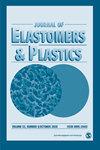(PA6/PP/PS)三元共混体系的形态发展及熔体线粘弹性性能
IF 1.6
4区 材料科学
Q4 MATERIALS SCIENCE, MULTIDISCIPLINARY
引用次数: 7
摘要
研究了PA6/PP/PS(70/15/15)三元共混物的形貌发展和熔体线粘弹性性能。利用帕里尔纳粘弹性模型结合扩散系数法对共混物组分的动态界面张力进行评估,试图预测这些共混物的形态发展。在温度为260℃、转速为60转/分的内混机中进行熔体共混制备共混样品。三元共混样品表现出明显的低频非末端存储模量,其值远远大于二元共混样品的弹性响应预测值。这归因于在三元共混样品中形成的核-壳复合液滴的强弹性阻力,这些样品的SEM显微照片证明了这一点。基于扩散系数的预测结果还表明,聚丙烯核被PS壳包裹,形成分散在PA6基体中的复合小相。结果表明,三元共混物的熔体粘弹性与形貌有密切的关系。本文章由计算机程序翻译,如有差异,请以英文原文为准。
Morphology Development and Melt Linear Viscoelastic Properties of (PA6/PP/PS) Ternary Blend Systems
The morphology development and melt linear viscoelastic properties of PA6/PP/PS (70/15/15) ternary blends were studied. An attempt was also made to predict the morphology development of these blends using the dynamic interfacial tension of the blend components evaluated from the Palierne's viscoelastic model in conjunction with spreading coefficient approach. The blend samples were prepared by melt blending in an internal mixer at temperature of 260°C and rotor speed of 60 rpm. The ternary blend samples exhibited a pronounced low-frequency nonterminal storage modulus whose values were much greater than those predicted for elastic response of the binary blend samples. This was attributed to strong elastic resistance of a core-shell composite droplet formed in the ternary blend samples that was evidenced by the SEM micrographs of these samples. The results predicted based on spreading coefficient concept also suggested a core-shell type morphology in which PP core was encapsulated by PS shell as a composite minor phase dispersed in PA6 matrix. It was demonstrated that there is a close relationship between melt viscoelastic properties and morphology of ternary blends.
求助全文
通过发布文献求助,成功后即可免费获取论文全文。
去求助
来源期刊

Journal of Elastomers and Plastics
工程技术-材料科学:综合
CiteScore
3.30
自引率
5.90%
发文量
41
审稿时长
6 months
期刊介绍:
The Journal of Elastomers and Plastics is a high quality peer-reviewed journal which publishes original research on the development and marketing of elastomers and plastics and the area in between where the characteristics of both extremes are apparent. The journal covers: advances in chemistry, processing, properties and applications; new information on thermoplastic elastomers, reinforced elastomers, natural rubbers, blends and alloys, and fillers and additives.
 求助内容:
求助内容: 应助结果提醒方式:
应助结果提醒方式:


